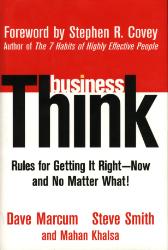Question
1: How did the theory of businessThink originate? What
made you decide to write a book?
Answer:
We were compelled to write businessThink because we see a lot
of unnecessary failure in business, which hasn’t changed in decades.
Having
experienced the failure first hand, we felt it was time to start
learning
from it rather than closing our eyes to it. What we noticed when we
opened
our eyes, was there are addictions we all have in business that get in
the
way of being great businessThinkers; the power we wield (or perceived
lack
thereof), our lack of curiosity in the name of "obedience," or playing
it
safe, playing politics, being defensive, crowding out others by our
arrogance,
speed for the sake of speed, being "busy"…the list could go on (for way
too long).
Question
2: Do the concepts you have set out in Businessthink apply across
cultures? Specifically, how much of what you list in your new book is
as applicable in Singapore as it is in New York or London and how
important is the cultural component in terms of what you have set out
in the book?
Answer:
In
response to the second question, our answer would be a resounding
YES! We
have taught these ideas in over 40 countries around the world,
including
India, China, Singapore, London, Australia, Hong Kong, Japan, Malaysia,
Korea, Taiwan, and Thailand just to name a few. We have found that many
of the principles are so fundamental that they transcend language
groups
and cultures. While there is usually some adaptation required for
culture
or personal style, they simply apply and work in most human
interactions to produce more effective outcomes.
Question
3: The concept of "face" is a very important one in Asia, how
does this concept relate to what you have set out in your new book
businessthink?
Answer: businessThink is an approach to
handling interactions with others in a better way, in a way that allows
everyone due credit for their ideas and contributions. The ability to
businessThink requires as a foundation the ability to create safety for
all to feel free to contribute their opinions and perspectives openly
and without fear of retribution or losing face. No ideas are stupid.
Rather businessThink seeks to build on the ideas of others no matter
how quirky they may seem. Involving others in decisions doesn't improve
the outcome unless there is a common platform for how you think
together, communicate together in a way that
sustains open dialogue and how you decide together.
It strikes us that
there is also a downside to "face" in Asian culture. Many
decisions that are poor are not recognized because to do so would have
a negative effect on the "face" of a superior. There seems to be a
strong influence in Asian business culture that is hierarchical and
perceived as very respectful. If business results are to be improved,
it seems that this respect and "face" can be preserved without having
to stamp out willingness of others to contribute. And it will have to
be done carefully wth language--the language of humility. It also seems
that many decisions are delayed or not made in order to
save "face" of the "boss" whose thinking may not be the best, yet there
is reluctance to say how you feel candidly.
We could be
completely wrong in our observations, but we have observed that this
challenge exists in organizations worldwide because a majority of
business interactions
are motivated by unhealthy ego. As a result, we make decisions based on
protecting one's ego.
Question
4: You talk about 8 rules that will produce this revolution and
will cultivate a fundamentally new way of thinking, communicating, and
decision-making in business, anywhere in the world, at any level in an
organization. How did you come up with them and which ones are the most
important?
Answer:
We developed these rules from our own time in the trenches, where we
failed as much as we succeeded. While they’re all important, "checking
your
ego at the door" and "driving curiosity" into every conversation,
meeting
and strategy session would make a huge impact if that’s all we did.
Just
look around your own organization and calculate the cost of ego. Most
people acknowledge it’s enormous.
Question
5: In teaching the business community how to "think" business all
of the time, what are the main behaviors they must change?
Answer:
The first, and maybe last, behavior is impulse control. We have to
resist our impulse to be "right" and take a step back—eliminate ego and
"turn
on" corporate curiosity. The higher the pain, the quicker we want to
get
rid of it, and so we aren’t willing to do vital critical thinking. We
let
our enthusiasm for a solution override our discipline to put our
decision through solid businessThinking.
Question
6: What workforce skills are most in demand and will be needed
most over the next two to five years?
Answer:
When Accenture interviewed 500 executives worldwide, and asked that
very question, the overwhelming answer was business skills (decision
making,
working cross-functionally, project management and communicating
effectively).
Surprisingly, not only did they need business skills the most, they
also
expect them to be in short supply. Yet most people think they have them
already.
Question
7: What do you think is the biggest obstruction to successful
leadership?
Answer:
Ego—it causes you to lead in an isolated, exclusionary, self-defined,
worship-worthy way. Ego shuts out thinking and curiosity in a company.
Additionally, it takes the very strengths that lead to great
leadership,
and imperceptibly turns them into weaknesses. For example, a great
leader
may have tremendous confidence as an attribute. When multiplied by ego,
confidence turns into a sense of infallibility. Perseverance when
multiplied
by ego easily turns into resistance to change or an unwillingness to
hear
others’ ideas.
Question
8: In businessThink, you use the term "solution seduction." What
is this?
Answer:
Companies seem to be addicted to "solutions." People want "quick fixes"
to the problems they face—and it ends up being neither a quick nor a
real fix. We have developed what seems to be a mutual conspiracy
between everyone to talk prematurely about a solution before there is
mutual understanding of the underlying issues, evidence, and financial
impact on the company.
Solutions have no inherent value—they only derive value from
the
problems they solve or the results they get. Then, and only then,
should
the discussion turn to the solution. The seductive part is
mental
adrenaline that talking about the "solution" creates and we are hooked
into thinking we are solving the problem, when in actuality we are not.
Question
9: In terms of looking for the best possible return on
investment, what big expense should be eliminated as it is often
mistaken for an answer, but is in fact a "fake solution"?
Answer:
Peter Drucker once said, "Marketing and innovation. Marketing and
innovation. Everything else is a cost." Any expense
(technology, training, teams, projects), no matter how vogue or
sophisticated it sounds, should be eliminated if it can’t justify its
own existence in increasing revenue or decreasing costs, compared to
other initiatives going on in
the company.
Question
10: In a sticky situation, what happens when people pound on the
panic button? What should they do instead?
Answer:
The situation gets stickier and people become more panicked in pursuit
of a fast solution. The tendency to panic, a subset of speed, makes
them
less discriminating about what it is they’re doing as long as they are
in fact doing something—anything. That’s why events
can feel like solutions because pure activity for activity sake is
disguised
as solving and creating, especially when they can spend money and form
teams; this frequently only gives the illusion of progress.
What
they should do is SLOW DOWN. If it’s true that they will
do something about the "sticky" situation, then their thinking better
be clear enough to find the evidence that proves both that they should
take action, and what specific action they should take.
Question
11: What is the most common topic that, upon being brought up, can
cause extreme discomfort? How can this discomfort be alleviated?
Answer:
It’s not the topic that’s the problem or the cause of discomfort—it’s
the reaction to the topic…the way things are communicated and received.
Anything should be a comfortable topic, and not off limits, if you know
how to businessThink it. The best way to address this is to
learn
to stop wrapping your self-worth around your ideas.
Question
12: What is the one question, a question that encourages people to
share their beliefs, opinions, observations, or viewpoints, that is
often overlooked but could be a quick route to a solution?
Answer:
There isn’t just one question. There are no easy answers, but
there is an easier way to get the right answers.
That’s why we
need to upgrade our mental operating systems to businessThink.
There
is an "ecology" of questions and responses that invite people to open
up
and share their perspectives. If there were one question it would be a
question to yourself regarding your intent, "Am I
looking
for validation of my own thoughts and agenda or am I truly interested
in what others candidly think and staying on the business agenda?"
Question
13: What is the purpose of the pursuit of business evidence?
Answer:
Pure and simple, it is PROOF. Just because someone thinks there is a
problem, does that make it so? Every decision to solve a problem is on
trial.
If it doesn’t go to trial with you first, it will definitely be on
trial
when you take it to the rest of the company, or when it hits the
marketplace.
Before you go to trial, you need a compelling case with evidence that
the
problem or opportunity you believe needs a solution actually
does
need a solution. If you don’t have evidence, there is no reason to do
anything—PERIOD.



